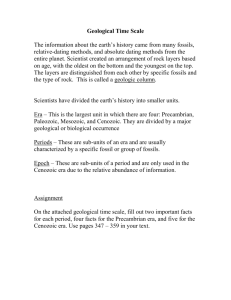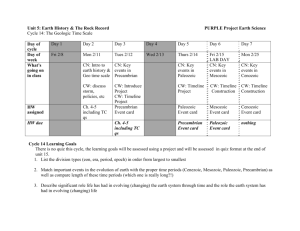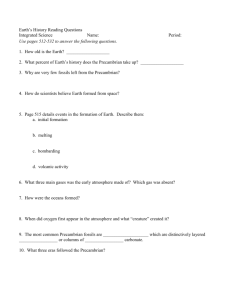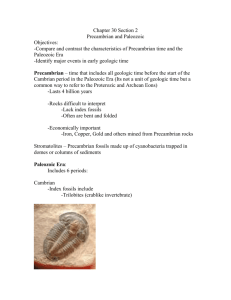Earth History: A Brief Summary
advertisement
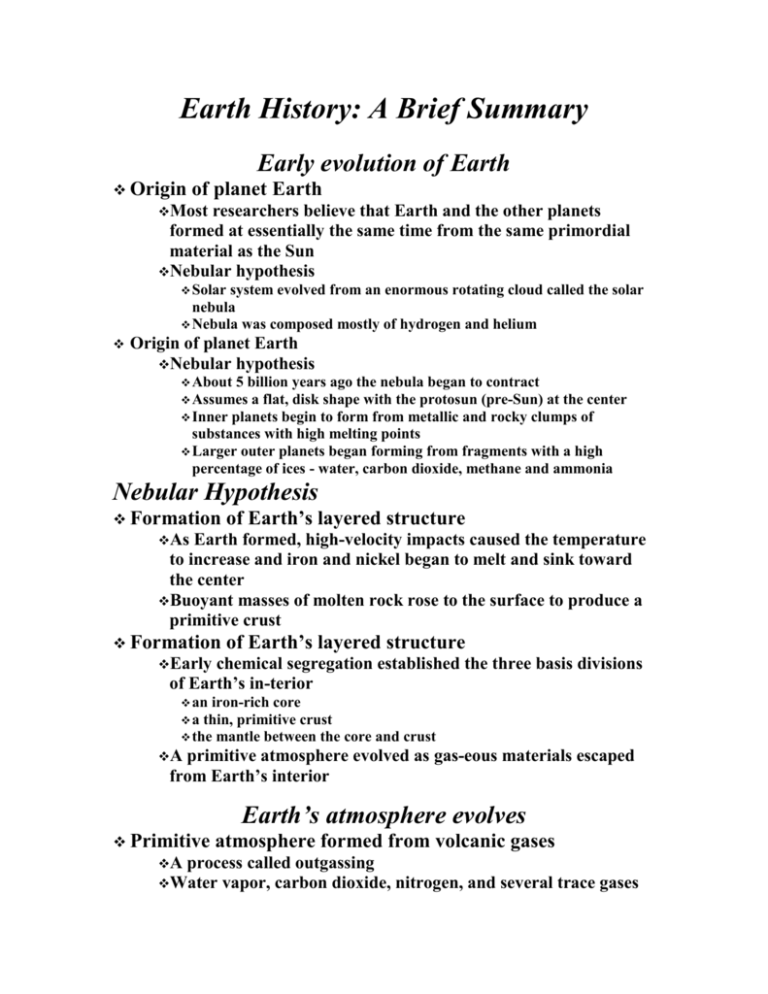
Earth History: A Brief Summary Early evolution of Earth Origin of planet Earth Most researchers believe that Earth and the other planets formed at essentially the same time from the same primordial material as the Sun Nebular hypothesis Solar system evolved from an enormous rotating cloud called the solar nebula Nebula was composed mostly of hydrogen and helium Origin of planet Earth Nebular hypothesis About 5 billion years ago the nebula began to contract a flat, disk shape with the protosun (pre-Sun) at the center Inner planets begin to form from metallic and rocky clumps of substances with high melting points Larger outer planets began forming from fragments with a high percentage of ices - water, carbon dioxide, methane and ammonia Assumes Nebular Hypothesis Formation of Earth’s layered structure As Earth formed, high-velocity impacts caused the temperature to increase and iron and nickel began to melt and sink toward the center Buoyant masses of molten rock rose to the surface to produce a primitive crust Formation of Earth’s layered structure Early chemical segregation established the three basis divisions of Earth’s in-terior an iron-rich core a thin, primitive crust the mantle between the core and crust A primitive atmosphere evolved as gas-eous materials escaped from Earth’s interior Earth’s atmosphere evolves Primitive A atmosphere formed from volcanic gases process called outgassing Water vapor, carbon dioxide, nitrogen, and several trace gases Very Water little free oxygen vapor condenses and forms primitive oceans as Earth cools Bacteria evolve Plants evolve and photosynthesis produces oxygen Oxygen content in the atmosphere increases By about 4 billion years after Earth formed, abundant ocean-dwelling organisms that require oxygen existed Earth’s history Precambrian era 4.5 billion to 540 million years ago 88% of Earth's history Only sketchy knowledge Most Precambrian rocks are devoid of fossils Precambrian era Precambrian rocks Most are buried from view continent has a "core area" of Precambrian rocks called a shield Extensive iron ore deposits Absent are fossil fuels Each Precambrian shields Precambrian era Precambrian fossils Most common are stromatolites Material deposited by algae Common about 2 billion years ago Microfossils of bacteria and algae have been found in chert Southern Africa (3.1 billion years of age) Lake Superior area (1.7 billion years of age) Precambrian era Precambrian Plant fossils fossils date from the middle Precambrian fossils date from the late Precambrian Diverse and multicelled organisms exist by the close of the Precambrian Animal The geologic time scale Paleozoic era 540 million years ago to about 248 million years ago First life forms with hard parts Abundant Paleozoic fossils Early Paleozoic history Southern Paleozoic Early continent of Gondwanaland exists era Paleozoic history North America barren lowland Seas move inland and recede several times and shallow marine basins evaporate leaving rock salt and gypsum deposits Taconic orogeny, a mountain building event, affects eastern North America A Reconstruction of early Paleozoic time Paleozoic Early era Paleozoic life Restricted to seas had not yet evolved Life consisted of several invertebrate groups Trilobites Brachiopods Cephalopods First organisms with hard parts, such as shells – began the Cambrian Explosion Vertebrates Paleozoic Late era Paleozoic history Supercontinent of Pangaea forms Several mountain belts formed during the movements of the continents World's climate becomes very seasonal, causing the dramatic extinction of many species Paleozoic Late era Paleozoic life Organisms diversified dramatically plants Fishes evolve into two groups of bony fish Lung fish Lobe-finned fish which become the amphibians Land Paleozoic Late era Paleozoic life Insects invade the land Amphibians diversify rapidly Extensive coal swamps develop Mesozoic era 248 million years ago to about 65 million years ago Often called the "age of dinosaurs" Mesozoic history Begins with much of the world's land above sea level Seas invade western North America Mesozoic era Mesozoic history Breakup of Pangaea begins forming the Atlantic ocean American plate began to override the Pacific plate Mountains of western North America began forming North Mesozoic era Mesozoic life Survivors of the great Paleozoic extinction become the dominant trees Reptiles (first true terrestrial animals) readily adapt to the dry Mesozoic climate Reptiles have shell-covered eggs that can be laid on the land Gymnosperms Mesozoic era Mesozoic life Dinosaurs dominate group of reptiles led to the birds Many reptile groups, along with many other animal groups, become extinct at the close of the Mesozoic One hypothesis is that a large asteroid or comet struck Earth Another possibility is extensive volcanism One Mass Extinctions Cenozoic era 65 million years ago to the present Often called the "age of mammals" Smaller fraction of geologic time than either the Paleozoic or the Mesozoic North America Most of the continent was above sea level throughout the Cenozoic era Cenozoic era North America Many events of mountain building, vol-canism, and earthquakes in the West Eastern North America Stable with abundant marine sedimen-tation Eroded Appalachians were raised by isostatic adjustments Cenozoic era North America Western North America Building of the Rocky Mountains was coming to an end Large region is uplifted – Basin and Range province is formed, Rockies are re-elevated, rivers erode the Grand and Black canyons, and volcanic activity is abundant Cenozoic era Cenozoic life Mammals replace reptiles as the dominant land animals Angiosperms (flowering plants with covered seeds) dominate the plant world Strongly influenced the evolution of both birds and mammals Food source for both birds and mammals Cenozoic era Cenozoic life Two groups of mammals evolve after the reptilian extinctions at the close of the Mesozoic Marsupials Placentals Cenozoic era Cenozoic life Mammals diversify quite rapidly and some groups become very large e.g., Hornless rhinoceros, which stood nearly 16 feet high Many large animals became extinct Humans evolve Humans Impact on Earth Key Terms Chapter 14 Photosynthesis Cell DNA Prokaryotes, eukaryotes Domain Evolution, natural selection Species Fossil Trace fossil Kingdom Gymnosperm, angiosperm Mass extinction Key Terms Chapter 15 Natural resource Renewable and non-renewable resources Fossil fuel Peat, lignite, bituminous, anthracite coals Petroleum, oil and natural gas, tar sand and oil shale Biomass energy Nuclear energy Hydroelectric energy Solar, tidal, wind energy Ore




